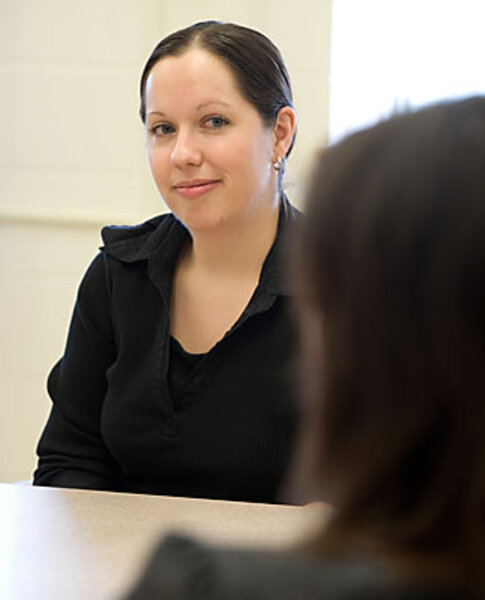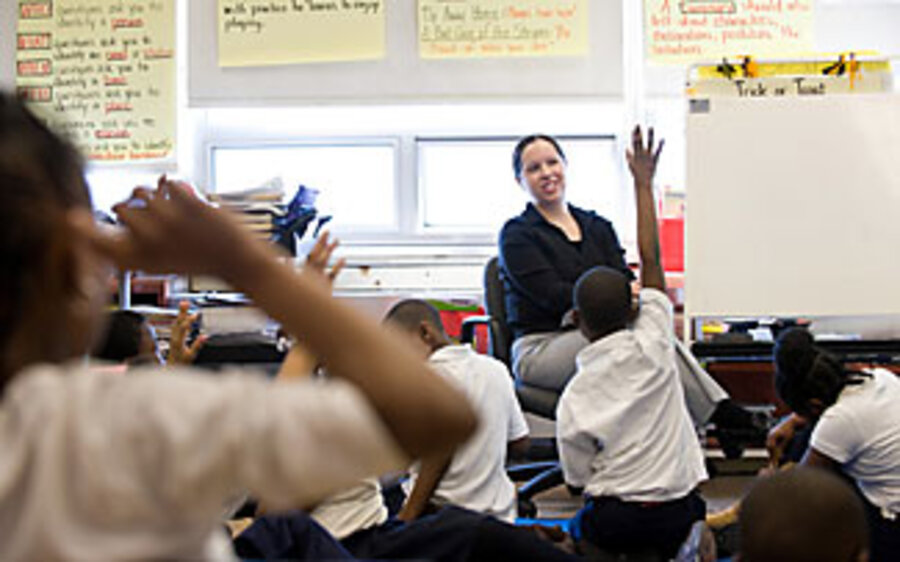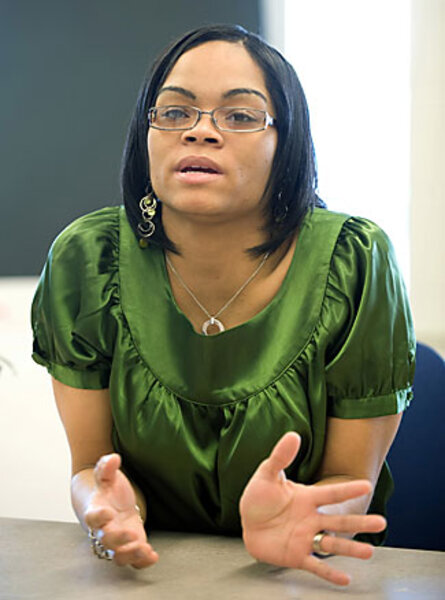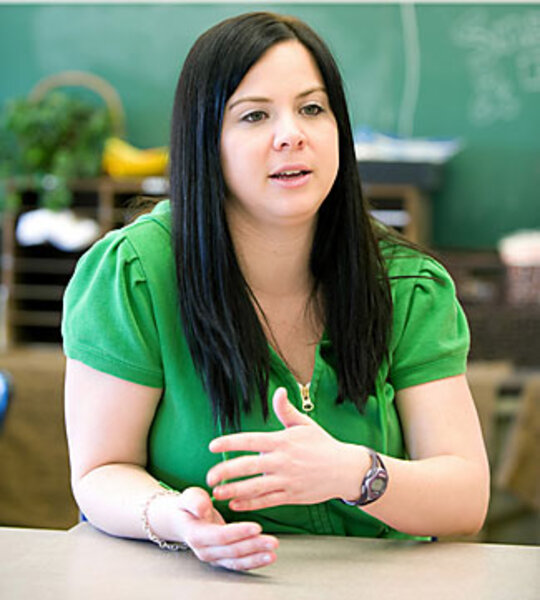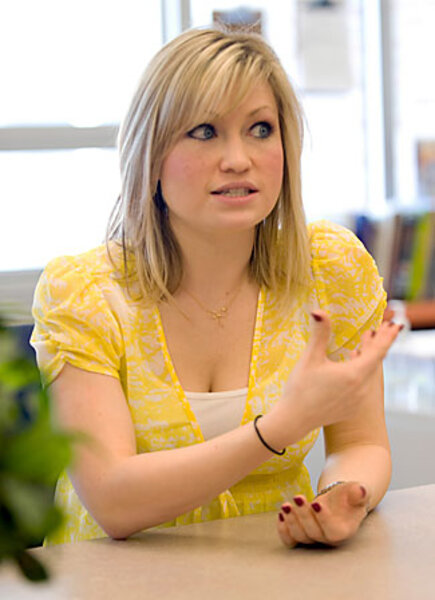Teacher training: what's the best way?
Loading...
| Chicago
Johanna Klinsky remembers her teacher training ruefully.
She loved the theory she learned, but her only classroom experience was 10 weeks of student teaching, which did nothing to prepare her for the chaos she would encounter as a teacher in an inner-city Chicago school.
"It was pure hell," she remembers. "I was wildly unprepared." In the end, though, she became part of the 55 percent or so of teachers who stick with the profession beyond five years. "But I guarantee you those kids didn't learn a thing," Ms. Klinsky says.
These days, she works as a coach in a Chicago teacher-preparation program far different from the one she went through: Aspiring teachers are paired with mentor teachers for a full year in urban classrooms before becoming teachers themselves. It's one model gaining attention right now as educators and policymakers debate how best to train teachers – particularly for the high-needs urban classrooms that need good teachers the most and are often saddled with those who are least-prepared.
There's now wide agreement that good teaching is the most crucial factor in raising student achievement. But when it comes to how to train those teachers – and how to make sure they are ready to hit the ground running and are likely to stick around – there's a deep ideological divide. Some policymakers say the focus needs to be on improving traditional education schools, which produce 4 out of 5 teachers in the United States. Others are strong advocates of so-called alternative models designed to streamline entry into teaching for exceptionally talented students or mid-career professionals.
"The vast majority of both traditional teacher-education programs and alternative certification programs are not meeting the needs of kids," says Barnett Berry, president of the Center for Teaching Quality in Hillsborough, N.C. The debate between the two is "a false dichotomy," he argues, since there is often far more variation in quality and design within the two camps than between them.
In particular, Mr. Berry notes, most programs right now are doing a poor job of preparing teachers for schools in high-poverty neighborhoods. "The pace of life in those schools is such that it's not all that amenable to learning on the job," he says. "It's too intense."
Not everyone agrees with that assessment, and some people point to studies showing that training makes little difference in teacher effectiveness.
"The variable that makes the most difference is the recruitment and selection on the front end," says Emily Feistritzer, president of the National Center for Alternative Certification in Washington. She's a proponent of easing the entry to the classroom, especially for well-qualified or older candidates who may be less inclined to return to school for a traditional teaching degree.
Alternative routes to teaching, which number more than 100, share certain
characteristics: They generally speed up the process of entering the profession, and usually, participants take at least some of the course work concurrently with the first year of teaching.
But the programs range from highly selective ones with finely honed training segments and good on-the-ground support to programs that many consider "degree mills" and may have no real supervised training.
One relatively new alternative model is the urban teacher residency. It produces only a small fraction of America's 3.9 million teachers, yet those going through the program seem to be well trained and willing to teach in the highest-needs classrooms – and to stay there for many years.
"There's traditionally a barrier between what happens in the classroom setting and what happens in university course work," says Anissa Listak, executive director of the Urban Teacher Residency Institute in Chicago. "Unlike traditional university programs where the course work is the center and the apprenticeship fits itself around that, the residency flips that on its head."
A full year in Chicago classrooms
The Academy of Urban School Leadership in Chicago, where Klinsky works now, is one of three well-established urban teacher residencies in the United States. Each AUSL resident spends a full year in Chicago classrooms, paired with a trained mentor-teacher who gives feedback, coaching, and a chance to gradually have more control over the curriculum. For that year, each resident is paid $32,000 by AUSL, a nonprofit. The money for such payments is obtained largely through fundraising.
The residents' in-classroom experience is accompanied by relevant education course work at a local university, culminating in a master's degree. In addition, the program demands that residents make a four-year commitment to continue teaching in Chicago schools when they graduate. For the first two years on the job, they can count on more coaching and support at their school.
The result: Even after the four-year commitment is up, more than 80 percent of AUSL grads are still teaching in Chicago classrooms, and 87 percent are involved in education in some way.
"The university does a good job of giving them content. We give them the hands-on experience of how to deliver it," says Debbi Thompson, a mentor-teacher at Chicago's Dodge Renaissance Academy. The K-8 school, where 86 percent of the students come from low-income families, is one of AUSL's six "teaching academies" in Chicago. It's also where Barack Obama announced his choice for education secretary.
Ms. Thompson is in the unusual position of having two residents in her classroom. Now, three-quarters of the way through the school year, each of them gets several weeks in which they take over all the lesson planning and teaching and receive feedback on how they've done. They've learned a lot, they say, but still have areas to work on – and they appreciate the length of time and the close mentor-resident relationship that they wouldn't get in a traditional program.
"Sometimes when you're in that moment with your kids, it's hard to see things you might be missing," says Danielle Silverman, referring to the benefits of having a mentor. She's just finished a poetry lesson with her fourth- and fifth-grade class, and it generally went well. But the feedback afterward, she says, helped her realize that she was giving directions to her students at the same time that she was posing questions and asking them to write.
In an aspect unique to Chicago's program, almost all AUSL grads end up being hired at certain "turnaround" schools that the city has given AUSL to run. These schools, among the worst performers in the city, have had their administration and most of the teaching staff replaced.
"If you're training people and just dispersing them into the system, they're going to get gobbled out by the system," says Alison Hilsabeck, dean of the education school at National-Louis University, where most AUSL residents take their courses and receive their master's degree. "How much more powerful to begin working school by school so you have powerful mentor-teachers ... and then placing the new teachers into turnaround schools with a strong staff and strong principal."
Urban teacher residencies exist in Boston and Denver, in addition to Chicago. And the Urban Teacher Residency Institute is trying to spread the model with a sort of "residency for residencies" training program. It's currently helping five residency projects that will begin next year: two in New York, one in Philadelphia, one in Denver (beyond the residency already there), and one in Chattanooga, Tenn.
Mr. Obama, during his campaign for president, called for 200 AUSL-like programs to be established across the US. His goal is to turn out 30,000 teachers a year through these residencies to work in America's toughest schools.
But for all the accolades they get, such programs are still tiny: AUSL has had just over 300 residents total in seven classes since the program began in 2001.
It's also very expensive. The program puts coaches in the schools and has other administrative costs, on top of the $32,000 payments.
Proponents argue that benefits on the back end – such as reduced teacher turnover and increased student achievement – more than make up for the expense.
"In the long run, if we don't pay the cost to create good teachers, it's penny-wise and pound-foolish," says Linda Darling-Hammond, an education professor at Stanford University in California. "Anytime you let someone go into the classroom before they're ready to be successful, there are all these other costs: of attrition and student failure, summer school, [students being held back a grade], the cost of dropping out."
How university programs run
Still, it is a tough sell. That's one reason some policymakers are putting their efforts into improving the 1,200 university-based teacher-preparation programs, where most teachers still get their training. "It's a big bang for the buck," says Arthur Levine, president of the Woodrow Wilson National Fellowship Foundation in Princeton, N.J., and former president of Columbia University's Teachers College in New York.
Most of these programs include more course work than urban teacher residencies, but they usually require considerably less student teaching – between six and 16 weeks.
Yet some universities are moving toward lengthier and more structured experiences in the field. Stanford University, for instance, runs an acclaimed master's program that is field-based, offers highly focused training, and makes extensive use of mentor-teachers. Schools like Bank Street College in New York and Alverno College in Milwaukee have also received praise.
But all too often, university programs are criticized for being divorced from what students will find in the classroom and for giving inadequate preparation to those planning to work in very rural or very urban districts.
Mr. Levine is working state by state to try to improve the quality of university-based training. In Indiana, where he has done the most work, his foundation is offering universities $500,000 in matching money that they can use to change their curricula. They're also offering those schools 20 fellowships of $30,000 each – similar, in some ways, to the residency model. The fellowships are for well-qualified individuals who make a three-year commitment to teach in high-needs urban schools and who get three years of intensive mentoring from the university.
Doing it state by state, Levine says, is conducive to getting the necessary coalitions on board among government, universities, school districts, unions, businesses, philanthropies, and other key players. And it makes for a more targeted impact. In Indiana, where four universities are participating, the efforts are increasing the number of math and science teachers by nearly 25 percent, according to Levine.
"I'm a pragmatist in these education wars," he says. "The universities tend to be too theoretical, and a lot of the alternative programs are too practical…. It would be really nice if we could meld the lessons of both."
One current weakness of many programs, Levine and others agree, is that at the same time they're under pressure to turn out higher-quality teachers, they're also under pressure to increase the number of teachers – which often leads to decreased admissions standards.
"If medicine starts to have a shortage of surgeons, they don't say, 'Let's get people of lesser ability.' In education, we lower the bar," says Thomas Lasley, dean of the education school at the University of Dayton in Ohio.
One failing of many large education schools, Dean Lasley adds, is that they don't do enough to prepare teachers for the specific needs of today's students, especially those in high-poverty neighborhoods. So the University of Dayton has started its own Urban Teacher Academy. Students committed to teaching in urban environments get training in the classroom and are paired with experienced teachers.
Stanford has also started its own schools. "This is the wave of the future," Professor Darling-Hammond says. "Medicine wasn't able to teach doctors how to practice better until they created teaching hospitals. Schools of education have to create teaching schools."
Back at Dodge Renaissance Academy, the students are used to having the teacher mentoring as part of the classroom experience, teachers say. And the focus on teaching has made a big difference: Between 2006 and 2007, a few years after AUSL turned it into a teaching academy, the portion of students passing state achievement tests jumped from 26 percent to 62 percent – the largest gain in the city during that period.
"I've gotten so much hands-on experience," says Lana Marchand, an AUSL resident who worked in human resources for six years before deciding she wanted to become a teacher.
Ms. Marchand is in her second day of taking over all the lesson preparation and teaching for her third-grade classroom – a task she's been working up to over the course of the year. During one exercise on nonfiction reading strategies, her mentor, Amy Versaw, unobtrusively takes notes on how well she holds students' attention.
"The engagement fluctuated, but she's grown a lot" in classroom management, Ms. Versaw says. "She feels more comfortable in her own skin as a teacher now."



